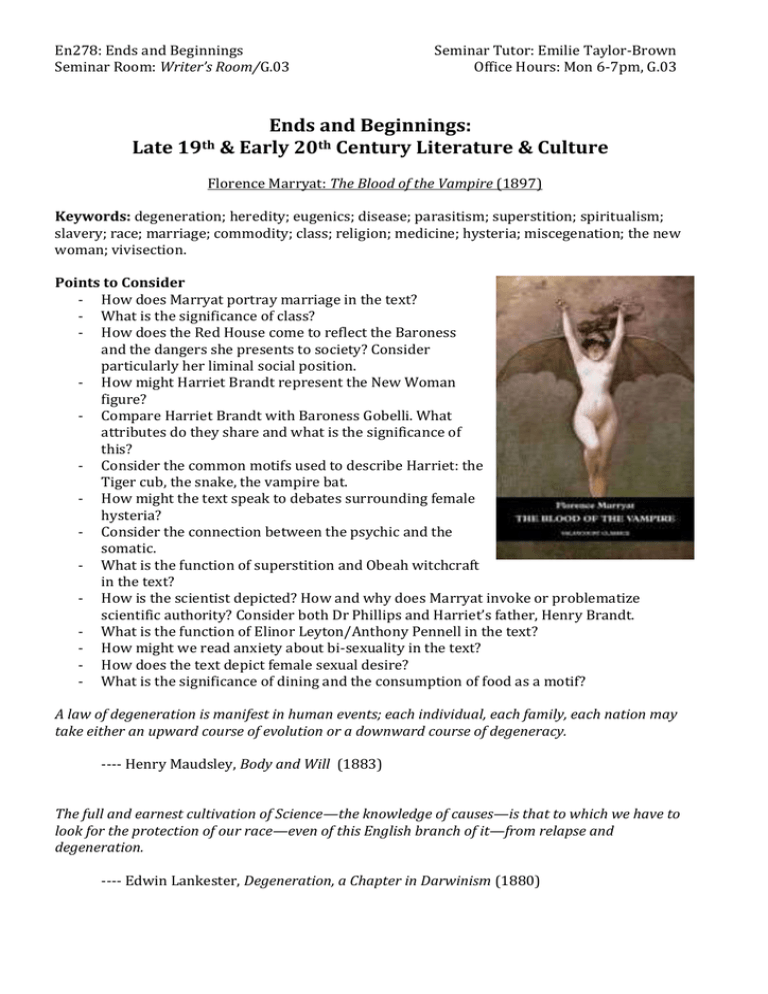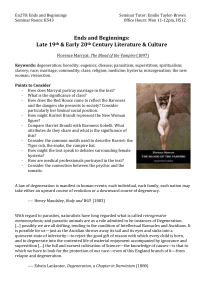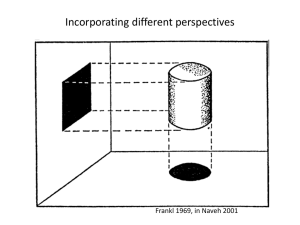
En278: Ends and Beginnings
Seminar Room: Writer’s Room/G.03
Seminar Tutor: Emilie Taylor-Brown
Office Hours: Mon 6-7pm, G.03
Ends and Beginnings:
Late 19th & Early 20th Century Literature & Culture
Florence Marryat: The Blood of the Vampire (1897)
Keywords: degeneration; heredity; eugenics; disease; parasitism; superstition; spiritualism;
slavery; race; marriage; commodity; class; religion; medicine; hysteria; miscegenation; the new
woman; vivisection.
Points to Consider
- How does Marryat portray marriage in the text?
- What is the significance of class?
- How does the Red House come to reflect the Baroness
and the dangers she presents to society? Consider
particularly her liminal social position.
- How might Harriet Brandt represent the New Woman
figure?
- Compare Harriet Brandt with Baroness Gobelli. What
attributes do they share and what is the significance of
this?
- Consider the common motifs used to describe Harriet: the
Tiger cub, the snake, the vampire bat.
- How might the text speak to debates surrounding female
hysteria?
- Consider the connection between the psychic and the
somatic.
- What is the function of superstition and Obeah witchcraft
in the text?
- How is the scientist depicted? How and why does Marryat invoke or problematize
scientific authority? Consider both Dr Phillips and Harriet’s father, Henry Brandt.
- What is the function of Elinor Leyton/Anthony Pennell in the text?
- How might we read anxiety about bi-sexuality in the text?
- How does the text depict female sexual desire?
- What is the significance of dining and the consumption of food as a motif?
A law of degeneration is manifest in human events; each individual, each family, each nation may
take either an upward course of evolution or a downward course of degeneracy.
---- Henry Maudsley, Body and Will (1883)
The full and earnest cultivation of Science—the knowledge of causes—is that to which we have to
look for the protection of our race—even of this English branch of it—from relapse and
degeneration.
---- Edwin Lankester, Degeneration, a Chapter in Darwinism (1880)
En278: Ends and Beginnings
Seminar Room: Writer’s Room/G.03
Seminar Tutor: Emilie Taylor-Brown
Office Hours: Mon 6-7pm, G.03
Making Monsters and the Metaphor of Parasitism
Parasite, n.
1. a. A person who lives at the expense of another, or of society in general; esp. (in early use) a
person who obtains the hospitality or patronage of the wealthy or powerful by obsequiousness
and flattery; (in later use, influenced by sense 2a) a person whose behaviour resembles that of a
plant or animal parasite; a sponger. Occas. also in extended use (of things). Chiefly derogatory.
2. a. Biol. An organism that lives on, in, or with an organism of another species, obtaining food,
shelter, or other benefit; (now) spec. one that obtains nutrients at the expense of the host
organism, which it may directly or indirectly harm.
Gothic fiction scavenges from many discursive fields and makes monsters out of bits and pieces of
science and literature […] ‘Gothic’ describes a discursive strategy, which produces monsters as a
kind of temporary, but influential response to social, political and sexual problems.
--- Judith Halberstam, “Technologies of Monstrosity: Bram Stoker’s Dracula” Cultural
Politics at the Fin de Siècle, eds. Sally Ledger and Scott McCracken. Cambridge: Cambridge
University Press, 1995. Print.
The parasite as a liminal and historically complex figure encapsulates anxiety about the robustness
of identity at the level of the personal, the social, and the national. The reimagining of the Gothic
monster as a hybrid of the social and organic parasite vocalises the fraught relationship between
what is biologically determined and what is culturally constructed.
--- Emilie Taylor-Brown, ““She has a Parasite Soul!” The Pathologization of the Gothic
Monster as Parasitic Hybrid in Bram Stoker’s Dracula, Richard Marsh’s The Beetle, and
Arthur Conan Doyle’s The Parasite” Monsters and Monstrosity from the Fin de Siècle to the
Millenium: New Essays eds. Sharla Hutchinson and Rebecca A. Brown. Jefferson:
McFarland, 2015. Print.
The presentation of a monstrous woman with vampiric tendencies, if not a ‘full-blown’ vampire,
clearly encodes nineteenth-century fears, which surrounded women who exhibited signs of
behaviour perceived to be transgressive. The figure of the vampire is clearly a malleable concept
and can be adapted to represent fin de siècle fears that threatened the stability of gender ideologies
concerning women.
--- Greta Depledge, ‘Introduction’ The Blood of the Vampire by Florence Marryat ed. Greta
Depledge. [1897] Victorian Secrets, 2010. Print.
Physiognomy and Parasitism
Don’t speak to me of her mother. She was not a woman she was a fiend, a fitting match for Henry
Brandt! To my mind she was revolting creature. A fat, flabby half-caste who hardly ever moved
out of her chair, but sat eating all day long until the power to move had almost left her! I can see
her now with her sensual mouth, her greedy eyes, her low forehead and half-formed brain, and
her lust for blood. (68)
En278: Ends and Beginnings
Seminar Room: Writer’s Room/G.03
Seminar Tutor: Emilie Taylor-Brown
Office Hours: Mon 6-7pm, G.03
She felt as if something or someone were drawing all her life away. She tried to disengage herself
from the girl’s clasp but Harriet Brandt seemed to come after her like a coiling snake, until she
could stand it no longer and faintly exclaim[ed] “Miss Brandt, let go of me please! I feel ill!” (18)
The natures of persons differ very widely. There are some born into this world who nourish
those with whom they are associated; they give out their magnetic power and their families, their
husbands or wives, children and friends, feel the better for it. There are those, on the other hand,
who draw from their neighbours, sometimes making large demands upon their vitality—sapping
their physical strength and feeding upon them, as it were, until they are perfectly exhausted and
unable to resist disease. (161)
You mustn’t know her, neither must miss Leyton. She comes from a terrible parentage. No good
can ever ensue from association with her […] Henry Brandt. You called him a doctor–he was not
worthy of the name. He was a scientist perhaps–a murderer certainly! […] Henry Brandt’s
barbarity was considered to render him unfit for association with civilised practitioners, and he
was expelled with ignominy. (67-8)
1. How do Marryat’s descriptions engage with nineteenth century ideas about
physiognomy and character?
2. How does the text interact with debates concerning parasitism and behaviourallyinduced degeneration?
3. What is the significance or function of parasitism as a social metaphor? How does
the physicality of vampirism relate to social anxieties?
Heredity, Degeneration and Racial Othering
Miss Brandt is a dangerous acquaintance for all of you. We medical men know the consequences
of heredity better than outsiders can do. A girl born in such circumstances–bred of sensuality,
cruelty, and heartlessness–cannot, in the order of things, be modest, kind, or sympathetic. (70)
“When the cat is black, the kitten is black too! It’s the law of Nature!”
“I don’t believe it! Miss Brandt bears no trace in feature or character of the parentage you
ascribe to her!”
“Does she not? Your assertion only proves your ignorance of character or characteristics.
The girl is a quadroon, and she shews it distinctly in her long-shaped eyes with their blue whites
and her wide mouth and blood red lips!” (77)
“It would be cowardly to desert a girl just because her father and mother happened to be brutes!
It is not her fault!”
“I quite allow that! Neither is it the fault of the madman that his progenitors had lunacy in
their blood, nor of a consumptive that his were strumous. All the same that facts effect the lives
of those with whom they come in contact. It is the curse of heredity! (78)
1. How does the text interact with debates concerning heredity?
2. How is race pathologised?
3. How does the text reflect debates concerning miscegenation?







